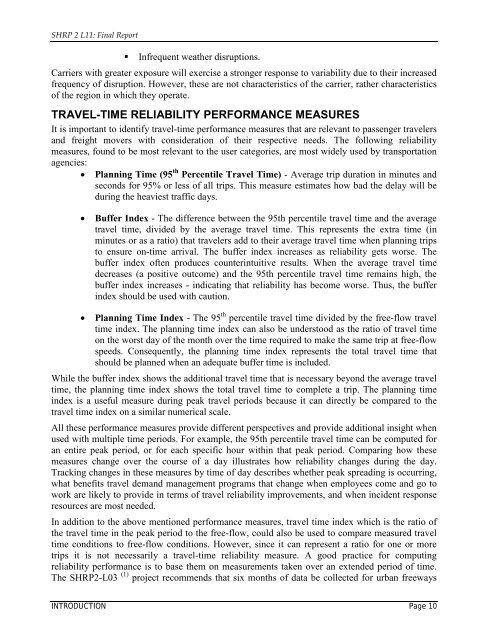Evaluating Alternative Operations Strategies to Improve Travel Time ...
Evaluating Alternative Operations Strategies to Improve Travel Time ...
Evaluating Alternative Operations Strategies to Improve Travel Time ...
You also want an ePaper? Increase the reach of your titles
YUMPU automatically turns print PDFs into web optimized ePapers that Google loves.
SHRP 2 L11: Final Report<br />
• Infrequent weather disruptions.<br />
Carriers with greater exposure will exercise a stronger response <strong>to</strong> variability due <strong>to</strong> their increased<br />
frequency of disruption. However, these are not characteristics of the carrier, rather characteristics<br />
of the region in which they operate.<br />
TRAVEL-TIME RELIABILITY PERFORMANCE MEASURES<br />
It is important <strong>to</strong> identify travel-time performance measures that are relevant <strong>to</strong> passenger travelers<br />
and freight movers with consideration of their respective needs. The following reliability<br />
measures, found <strong>to</strong> be most relevant <strong>to</strong> the user categories, are most widely used by transportation<br />
agencies:<br />
• Planning <strong>Time</strong> (95 th Percentile <strong>Travel</strong> <strong>Time</strong>) - Average trip duration in minutes and<br />
seconds for 95% or less of all trips. This measure estimates how bad the delay will be<br />
during the heaviest traffic days.<br />
• Buffer Index - The difference between the 95th percentile travel time and the average<br />
travel time, divided by the average travel time. This represents the extra time (in<br />
minutes or as a ratio) that travelers add <strong>to</strong> their average travel time when planning trips<br />
<strong>to</strong> ensure on-time arrival. The buffer index increases as reliability gets worse. The<br />
buffer index often produces counterintuitive results. When the average travel time<br />
decreases (a positive outcome) and the 95th percentile travel time remains high, the<br />
buffer index increases - indicating that reliability has become worse. Thus, the buffer<br />
index should be used with caution.<br />
• Planning <strong>Time</strong> Index - The 95 th percentile travel time divided by the free-flow travel<br />
time index. The planning time index can also be unders<strong>to</strong>od as the ratio of travel time<br />
on the worst day of the month over the time required <strong>to</strong> make the same trip at free-flow<br />
speeds. Consequently, the planning time index represents the <strong>to</strong>tal travel time that<br />
should be planned when an adequate buffer time is included.<br />
While the buffer index shows the additional travel time that is necessary beyond the average travel<br />
time, the planning time index shows the <strong>to</strong>tal travel time <strong>to</strong> complete a trip. The planning time<br />
index is a useful measure during peak travel periods because it can directly be compared <strong>to</strong> the<br />
travel time index on a similar numerical scale.<br />
All these performance measures provide different perspectives and provide additional insight when<br />
used with multiple time periods. For example, the 95th percentile travel time can be computed for<br />
an entire peak period, or for each specific hour within that peak period. Comparing how these<br />
measures change over the course of a day illustrates how reliability changes during the day.<br />
Tracking changes in these measures by time of day describes whether peak spreading is occurring,<br />
what benefits travel demand management programs that change when employees come and go <strong>to</strong><br />
work are likely <strong>to</strong> provide in terms of travel reliability improvements, and when incident response<br />
resources are most needed.<br />
In addition <strong>to</strong> the above mentioned performance measures, travel time index which is the ratio of<br />
the travel time in the peak period <strong>to</strong> the free-flow, could also be used <strong>to</strong> compare measured travel<br />
time conditions <strong>to</strong> free-flow conditions. However, since it can represent a ratio for one or more<br />
trips it is not necessarily a travel-time reliability measure. A good practice for computing<br />
reliability performance is <strong>to</strong> base them on measurements taken over an extended period of time.<br />
The SHRP2-L03 (1) project recommends that six months of data be collected for urban freeways<br />
INTRODUCTION Page 10















